The definition of mindfulness is simple and complex. One good way to get to know what the definition of mindfulness is just to look at how other people have defined it.
Jon Kabat-Zinn has said, “Mindfulness is paying attention, on purpose, in the present moment and non-judgmentally; [or in other words,] knowing what you are doing while you are doing it.“
In short, it is simply being present with what is. It is observing what is present for you.
Mindfulness is simple, but takes work
The practice of mindfulness is simple. You are simply present with what is. That’s kind of hard to do, so most people start with focusing on the breath in meditation. You simply breath naturally and focus on your breath. It is OK to have thoughts, but if you get carried away by your thoughts, simply come back to your breath.
Mindfulness is a skill that should be practice. Some people can engage in mindful meditation for hours, but it seems like a huge task as a beginner to practice for 5 minutes.
Mindfulness and emotions
So often our thoughts and emotions can carry us away. When we feel anger, we tend to think about what makes us anger and feel even angrier. When we are frightened or worried, we think about makes us frightened or worried and get even more frightened or worried.
Mindfulness helps us to work with our emotions and thoughts because we are training to simply observe the emotions and thoughts. We observe that there is a thought or an emotion. We do not reject the thought or emotion. But we just continue to focus on the breath.
In this way, we tend to be less carried away by emotions and thoughts after practicing the skill of mindfulness
Mindfulness and sleep
Mindfulness is important for sleep because one of the reasons it is hard to sleep is that we get carried away by stressful emotions and thoughts. We lay down to sleep and immediately our minds start racing with thoughts about the day, worrying situations, or even the fear that we won’t be able to sleep.
Mindfulness helps because it allows us to observe these thoughts without being carried away by them.
There are studies that show mindfulness is effective for sleep. A recent review summaried scientific articles and found that mindfulness based interventions are effect at improving symptoms of insomnia and sleep quality. Another study tested virtual mindfulness training a found that virtual mindfulness training is as effective other, in-person forms of mindfulness training.
Mindfulness and dreams
Practicing mindfulness will also help you explore your dreams. There is recent research that shows a number of interesting findings.
For example, a study found that mindfulness and meditation can improve mood as well as enhance engagement and reflectiveness in dreams. Another study found that long term meditation is associated with longer dreams with more friendly interactions with dream characters. And better short term memory is associated with more increased dream recall and mindfulness has been associated with better short term memory.
So it is clear that there is a link between mindfulness and dreaming.
DreamWell’s Mindfulness Practices

DreamWell offers a number of practices specifically for working with and practicing mindfulness These are here for you to explore and support you in your mindfulness practice.
Basic Mindfulness
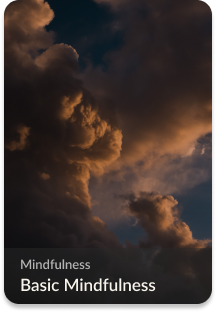
Mindfulness often helps people calm the mind before sleep. It allows us to be present during the day which can help prepare the mind to easily prepare for sleep. It gives us tools for when the active mind prevents sleep.
Basic Mindfulness covers the basics of mindfulness practice by focusing on the breath. It will provide the foundation of everything you need to experience mindfulness.
This practice is intended to be an introduction to mindfulness and can be used during the day or before sleep. Listen to this whenever you want to experience the breath and the present moment with a new mind.
Morning Mindfulness Practice

The transition from sleep to wake can be a foundation for how you think about sleep and how you experience the day.
The Morning Mindfulness Practice is intended to support you as you mindfully make the transition from sleep to wake. It is intended to be practiced in the morning, day after day.
Evening Mindfulness Practice
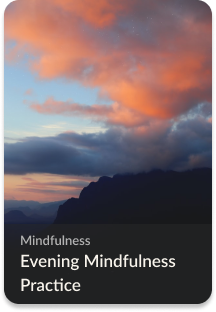
The transition from wake to sleep can be a powerful time as we review the day and prepare for sleep, deep rest, and dreams.
The Evening Mindfulness Practice is intended to support you as you mindfully make the transition from wake to sleep. It is intended to be practiced in the evening, night after night.
Gratitude

Acknowledge that you are here. Change your perspective. Connect in with yourself and your heart. Feel gratitude and sleep well.
While this practice is intended to be used to transition from the waking day to a restful sleep, this practice can be used at any time to connect in with gratitude.
Slowing Down
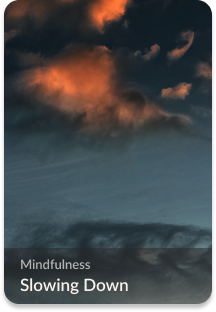
Stress held in the body or mind will obstruct our ability to sleep well. Slowing down, softening, and opening up to our current experience will allow sleep to come. Mindfulness practices are useful for reducing stress in the present moment.
This practice is intended to be used at any time, either during the day or as a way to prepare for sleep. It invites you to incorporate mindfulness into your day and sleep routines.
Inquiry
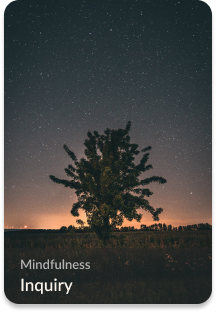
Your body and mind know how to sleep and dream well, but sometimes we may forget. Take a moment to just remember what it felt like to rest.
Inquiry is a guided meditation that invites you to explore how rest manifests in your life. This practice is intended to be used at any time, either during the day or as a way to prepare for sleep.
Body Scan
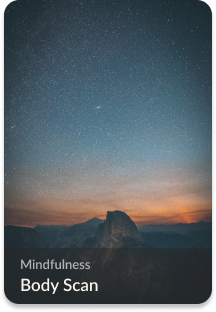
Relax and develop mindfulness through this body scan. You’ll bring attention and awareness to parts of your body, starting with your head and moving down to your feet.
This practice can be used day or night. Body Scan is a particularly useful practice to prepare for sleep because it relaxes the body and min.
Reversed Body Scan
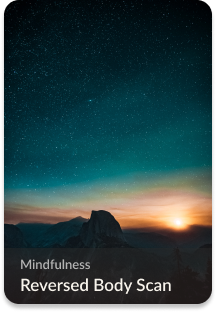
Relax and develop mindfulness through this body scan. You’ll bring attention and awareness to parts of your body, starting with your feet and moving up to your head.
This practice can be used day or night. Reverse Body Scan is a particularly useful practice to prepare for sleep because it relaxes the body and mind.
Sensation

Sensations, like the breath, are ever present. You can use sensation, like the breath, to connect with the present. Experience the present moment by being aware of the sensation of your body and the sensation of your mind.
This practice is intended to be used during the day or night. It can be used to calm the mind before sleep.
Non-judgement

Judging our experience often creates trouble sleeping. We want to sleep. We cannot sleep. We judge our experience. We reject it. Sleep seems even farther away.
Non-judgment is about just experiencing and accepting. This practice is intended to be used at any time, either during the day or as a way to prepare for sleep.





